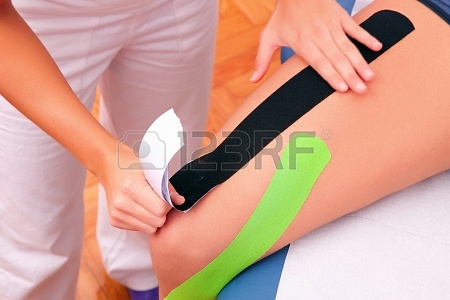You may have noticed that many volleyball players, and basketball players at the 76 UAAP season were competing with visible strips of tape on various parts of their bodies.
They’ve been hard to miss at this year’s UAAP: Strips of brightly colored tape adorning the arms, legs, and torsos of many top players. But more than just fashion is driving this trend.
The tape is called Kinesio tape. Many athletes believe it has medical benefits.
The tape was invented by Japanese chiropractor Kenzo Kase in the 1970s. The U.K. web site for Kinesio tape claims it can alleviate pain, reduce inflammation, relax muscles, enhance performance, and help with rehabilitation as well as supporting muscles during a sporting event.
What Does Kinesio Taping Do?
Kinesio Taping gives support and stability to your joints and muscles without affecting circulation and range of motion. It is also used for Preventive Maintenance, Edema, and to treat pain.
Kinesio Taping is a technique based on the body’s own natural healing process. This Kinesio Taping exhibits its efficacy through the activation of neurological and circulatory systems. This method basically stems from the science of Kinesiology, hence the name “Kinesio”. Muscles are not only attributed to the movements of the body but also control the circulation of venous and lymph flows, body temperature, etc. Therefore, the failure of the muscles to function properly induces various kinds of symptoms.
Consequently, so much attention was given to the importance of muscle function that the idea of treating the muscles in order to activate the body’s own healing process came about. Using an elastic tape, it was discovered that muscles and other tissues could be helped by outside assistance. Employment of Kinesio Taping creates a totally new approach to treating nerves, muscles, and organs. The first application of Kinesio Taping was for a patient with articular disorders.
For the first 10 years, orthopedists, chiropractors, acupuncturists and other medical practitioners were the main users of Kinesio Taping. Soon thereafter, Kinesio Taping was used by the Japanese Olympic volleyball players and word quickly spread to other athletes. Today, Kinesio Taping is used by medical practitioners and athletes around the world.
The Kinesio Taping Method is applied over muscles to reduce pain and inflammation, relax overused tired muscles, and to support muscles in movement on a 24hr/day basis. It is non-restrictive type of taping which allows for full range of motion.
In contrast, traditional sports’ taping is wrapped around a joint strictly for stabilization and support during a sporting event obstructing the flow of bodily fluids as an UNDESIRABLE side-effect.
Kinesio Tape is used for anything from headaches to foot problems and everything in between. Examples include: muscular facilitation or inhibition in pediatric patients, carpal tunnel syndrome, lower back strain/pain (subluxations, herniated disc), knee conditions, shoulder conditions, hamstring, groin injury, rotator cuff injury, whiplash, tennis elbow, plantar fasciitis, patella tracking, pre and post surgical edema, ankle sprains, athletic preventative injury method, and as a support method.

